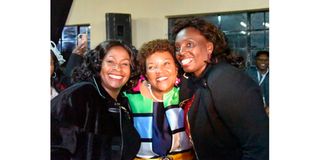Election 2022: More women elected but Kenya still tails in EA bloc

From left: Machakos County Governor-elect Wavinya Ndeti, Senator-elect Agnes Kavindu Muthama and Woman Rep Joyce Kamene when they were declared winners of the just-concluded poll at the Machakos Academy on August 13, 2022.
What you need to know:
- Kenya has the least representation of women among the six countries, which have a uniform electoral quota.
- National Gender and Equality Commission has recorded 30 women who were elected to represent single constituencies.
- Eight women are likely to be nominated considering the current number of elected women, raising representation to 24.36 per cent, far below the two-thirds gender principle.
Even with the election of more women into the National Assembly in the just-concluded poll, Kenya still tails among the East African (EA) countries with a gender quota.
Out of the seven countries in the EA bloc, only the Democratic Republic of the Congo lacks the electoral quota.
Of the 500 legislators in its National Assembly, only 64 are women, a 12.8 per cent representation according to the Inter-Parliamentary Union (IPU), a global organisation of national parliaments.
While Kenya has the least representation of women among the six countries which have a uniform electoral quota, allocating 30 per cent of the elective seats to women.
The other countries include Burundi, Rwanda, South Sudan, Uganda and Tanzania.
Rwanda leads with the highest mark exceeding 50 per cent. Its house has a 61.25 per cent representation of women based on data from IPU.
South Sudan
Two countries have passed the 30 per cent quota by nearly nine per cent and seven per cent respectively.
Burundi has 38.21 per cent representation followed by Tanzania with 36.86 per cent. While Uganda and South Sudan hit below the 35 per cent mark.
However, Uganda has a higher number at 33.81 per cent compared to South Sudan at 32.36 per cent.
Kenya is in its own league.
Before the 2022 General Election, the National Assembly constituted 21.77 per cent of women. This calculation is based on the 23 women elected Members of Parliament (MPs), 47 County Woman Representatives and six nominated MPs.
National Gender and Equality Commission has recorded 30 women who were elected to represent single constituencies. Now, even with seven more elected women, the National Assembly does not meet the 30 per cent threshold.
Article 97 (1c) provides for nomination of 12 MPs to represent special interests including the youth, persons with disabilities and workers.
Eight women are likely to be nominated considering the current number of elected women.
This would only raise the representation to 24.36 per cent, far below the two-thirds gender principle.
In Rwanda, political parties drive the attainment of the electoral quota. In the reverse, in Kenya, political parties have to be forced to nominate women to compete for elective seats.
Last May when the Independent Electoral and Boundaries Commission rejected nomination lists that failed the gender quota requirement, political parties protested.
Finally, they got a reprieve when the High Court suspended the directive. But in Rwanda, there is no joy in reprieve.
“The bottom line is that there is an Organic Law and political parties have to adhere to it. They know inclusion is not someone (else’ prerogative) to decide. It is a must. It is a must that it has sunk deep into our deeds,” Emma Furaha, a member of Rwanda’s Chamber of Deputies and chairperson of Committee on Political Affairs and Gender said in an earlier interview.





